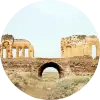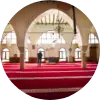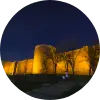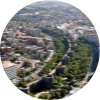
















Medrese Mosque, originally built as a madrasa (theological school), has served various purposes throughout different periods. According to the construction inscription, the mosque was commissioned by Çeteci Abdullah Pasha in the year 1170. Abdullah Pasha served as the governor of Diyarbakır five times during the Ottoman era and earned the nickname "Çeteci" (meaning "fighter") for his successful struggle against urban bandits to ensure the orderly and rule-compliant performance of the Hajj pilgrimage.
Abdullah Pasha was known for his skills as a calligrapher, poet, scholar, and generous person. He passed away in 1760 and was buried in a cemetery outside Dağ Kapı (Mountain Gate), but since the cemetery was removed, the exact location of his grave is unknown today.
During the reign of Sultan Abdülhamid II, the mosque was temporarily used as Çermik Rüştiye Mektebi (secondary school). Later, some parts of it were demolished, and some of its cells were converted into shops. In 1974, it was used as the Quran Course building of the district. Subsequently, the entire madrasa, restored by the Çermik Mosque Construction Association, is now used as a mosque.
The mosque has a rectangular plan with cells lining the three sides of the central courtyard, surrounded by colonnades. Recently, the courtyard has been arranged, and repairs and alterations have been made to the colonnades and the facade facing the courtyard.
The land area of the Medrese Mosque is 600 square meters, the mosque area is 450 square meters, and it has a congregation capacity of 1000 people. The mosque is registered in the database of the General Directorate of Foundations under the name "Çarşı (Medrese) Mosque" with inventory number 21 02.01/03, and it is among the "Cultural Heritage of Turkey."